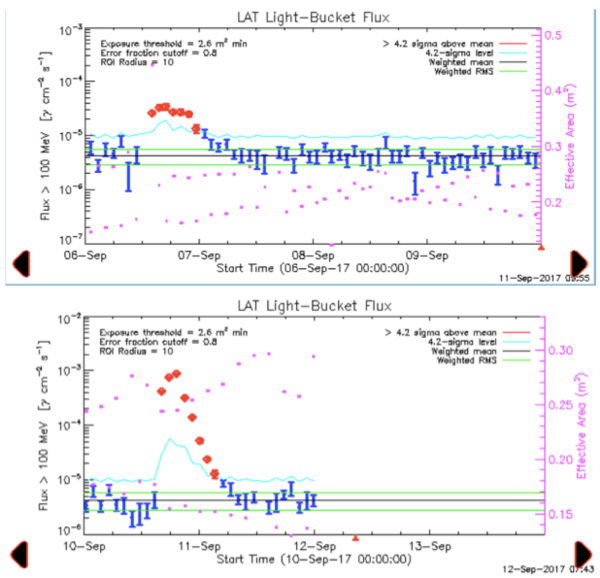The Kelvin Force and Loop-Top Concentration
From RHESSI Wiki
(initial upload of 306) |
|||
| Line 17: | Line 17: | ||
This consequence is easy to understand if the | This consequence is easy to understand if the | ||
[https://en.wikipedia.org/wiki/Larmor_precession#Larmor_frequency Larmor frequency] | [https://en.wikipedia.org/wiki/Larmor_precession#Larmor_frequency Larmor frequency] | ||
| - | + | is greater than the collision frequency; the particle | |
will move in a circle in 2D, or in a helical path in 3D. | will move in a circle in 2D, or in a helical path in 3D. | ||
In the absence of strong gradients this gyrational motion is the first of | In the absence of strong gradients this gyrational motion is the first of | ||
| Line 82: | Line 82: | ||
[[File:306f1.png|600px|thumb|center|Figure 1: | [[File:306f1.png|600px|thumb|center|Figure 1: | ||
| - | A "white-light prominence," in which Thomson scattering provides | + | A "white-light prominence," (right) in which Thomson scattering provides |
direct evidence for plasma concentration at the tops of coronal | direct evidence for plasma concentration at the tops of coronal | ||
loops (Ref. [2]). | loops (Ref. [2]). | ||
| + | Much later in the flare development, a typical Hα loop prominence system develops, | ||
| + | but the process of overdense loop formation is continuous and may continue for hours at higher and | ||
| + | higher altitudes. | ||
]] | ]] | ||
Revision as of 21:14, 15 September 2017
| Nugget | |
|---|---|
| Number: | 306 |
| 1st Author: | Kiyoto Shibasaki |
| 2nd Author: | and Hugh Hudson |
| Published: | 18 September 2017 |
| Next Nugget: | GLE 72 |
| Previous Nugget: | Neutralized Currents] |
| List all | |
Contents |
Introduction
The Lorentz force causess charged particles in a magnetized plasma to gyrate in a plane perpendicular to the direction of the field. This consequence is easy to understand if the Larmor frequency is greater than the collision frequency; the particle will move in a circle in 2D, or in a helical path in 3D. In the absence of strong gradients this gyrational motion is the first of the three adiabatic invariants of charged particles in a plasma, an extremely convenient concept for understanding the Van Allen Belts, for example.
But what happens when the collision frequency increases and the plasma becomes a fluid, in the MHD approximation to plasma kinetic physics? Does the Lorentz force cease to be important? This question underlies the important Bohr-Van Leeuwen theorem, first reported in the independent PhD theses of Niels Bohr and Hendrika Van Leeuwen. According to this theorem, the bulk magnetism of a solid cannot be explained by classical physics and must have a quantum-mechanical explanation.
The theorem, based on statistical mechanics and classical physics, asserts that the net magnetism of a body in thermal equilibrium simply vanishes. Thus, quite surprisingly, any magnetic effect on an equilbrium solid body (diamagnetism, paramagnetism, ferromagnetism) requires an explanation based on quantum physics. How does this result apply to an inhomgenous plasma? It would be safe to say that these concepts do not often get addressed in practical research affairs in solar physics. But what if they were decisively important? In a magnetic fluid the a fluid approximation (MHD), this is called the Kelvin force. In a plasma this represents the bulk force resulting from the magnetic moment associated with the gyrations of the individual particles. In this Nugget we describe a possible application of the Kelvin force to solve a perplexing problem that arose largely from the soft X-ray observations of the Yohkoh SXT soft X-ray telescope: what supports loop-top concentrations of plasma in solar flares?
=== The Observations ==-
The loop-top concentrations in solar flares can be seen in a number of ways: soft X-rays (commonly), microwaves (Ref. [1]), and white light. Figure 1 provides an illustration that is little known or appreciated: a "white light prominence" (Ref. [2]). This rare kind of event is hard to observe, but probably also very common; typically one sees loop-top concentrations better at wavelengths with high image contrasts. White-light views such as this one are hampered by the glare of the photosphere, but the emission mechanism is probably the same as for a coronagraphic white-light view: Thomson scattering, and therefore a direct measure of column density. What we see seems like a large mass elevated mysteriously to coronal heights by the flare. Such a concentration is inconsistent with hydrostatic equilibrium.

The Mathematics
We do not present a detailed derivation here, but note that the Larmor motion of the constituent particles produces a magnetic moment M and results in a net magnetic field B = μ0(H + M), where B is the magnetic induction and H the magnetic field strength as spelled out in Maxwell's equations. The M term is not present in classical MHD theory and, in the real world, must be included. This leads to the Kelvin force
and then to a revised formula for the MHD equation of motion:
We have simulated a simple dipole flux tube, as shown in Figure 2, and find that with the inclusion of the Kelvin force the excess mass concentration at loop top results naturally.
Conclusions
References
[1] "Loop-Top Nonthermal Microwave Source in Extended Solar Flaring Loops"
[2] "White-light flare observed at the solar limb"
| RHESSI Nugget Date | 18 September 2017 + |
| RHESSI Nugget First Author | Kiyoto Shibasaki + |
| RHESSI Nugget Index | 306 + |
| RHESSI Nugget Second Author | and Hugh Hudson + |
